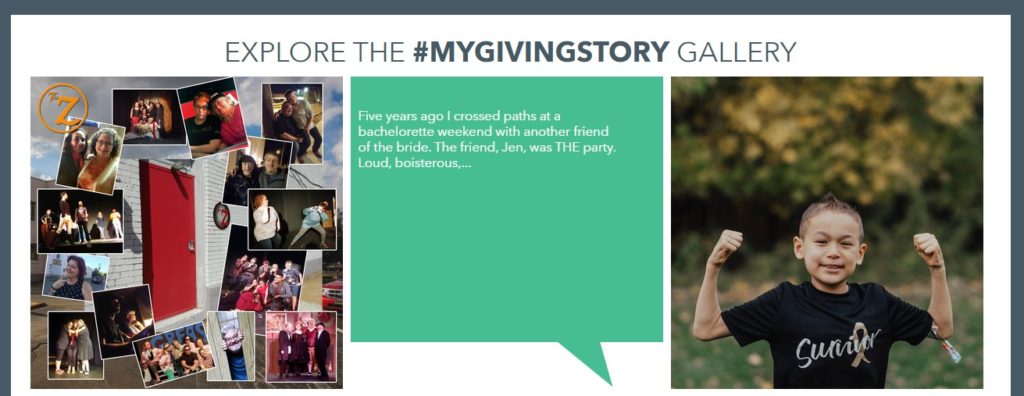We all know that it’s important to collect testimonials and stories to use in your nonprofit’s website content, campaigns, fundraising asks and various other marketing pieces. Harnessing the power of a good story can inspire your audience to action.
But who do you ask? Where do you start?
Determine the Stories You Need
There are many types of stories your nonprofit might tell. Even a new nonprofit! Get strategic about your ideal stories, how it highlights your mission and what you do, and whose voice it amplifies to your audience.
What kinds of stories and testimonials are missing in your strategy? The more specific you can be in answering this question, the more you can target your collection efforts. For example, maybe you’re looking for successful participants from a particular program or are missing volunteer voices on your website.
Once you know what you’re looking for, you have a ready-made target audience to reach out to through your various channels.
Ways to Collect Testimonials and Stories
Now that you have a better idea of what you’re looking for, you can choose the best way to cast out your net and actually get it. As an example, Megan Silvestri at The Stability Network shared how they collect and use stories to inspire their audience:
We use stories to inspire and encourage people experiencing mental health challenges to thrive. Our storytellers – or Stability Leaders as we call them – find us through speaking engagements, referrals of friends or colleagues, social media, and our website. When our Stability Leaders speak out about their experiences, it signals to others that they are not alone and that it is possible to thrive with any mental health diagnosis. Everyone has a unique story to share, and for many, the driving force in sharing their stories is knowing that it will help someone else.
Megan Silvestri, The Stability Network
Which story collection methods will work best for your organization? Pick and choose from the following methods based on the story you want and the audience of folks who can give it to you.
Create a Share Your Story Page
Building a Share Your Story page and form is an easy way to passively collect testimonials and stories on your website. As one simple place to send people from other pages and marketing channels, it’s a great tool to have in your arsenal and can easily be combined with other collection methods.
Consider adding specifications within the introduction to the form to set some parameters for the types of stories you’re looking for to make your search a bit more fruitful. And, to draw more visitors to the page from around your site, try promoting the page in places like the sidebar, your blog and on the homepage.
Make Sure You Have Permission
When collecting testimonials and stories through a form on your site, you’ll want to make sure to get permission to use any quotes and photos that people submit. See how Aging Ahead gets permission to use stories through form fields like a story and photo release agreement box.
Ask Social Media Followers
It never hurts to ask! Depending on your mission and community on social media, followers may jump at the chance to be featured online. See someone new commenting on posts or participating in groups? Find a powerful or sweet photo from someone in your network? Reach out to them and find out the story behind it!
After their first virtual advocacy day, the National Foundation for Ectodermal Dysplasias posted on Facebook to ask participants for photos of their families advocating.
And, when sharing stories or quotes on social media, it’s a great opportunity to let people know that you’re looking for more! In this example from Teach for America, they include a variety of video stories before wrapping up the video with a call for additional stories on the topic.
Check Online Reviews
Online reviews from places like Google, Facebook and Great Nonprofits are another option for finding happy supporters to reach out to for stories and testimonials. People who left good reviews for your nonprofit have had a positive experience and already feel somewhat comfortable putting their name on a story, experience or opinion of your organization. Depending on the review and source, you may even be able to use pieces of the review itself on your website.
Run a User-Generated Content Campaign
Stories and testimonials are types of user-generated content, as is anything else that someone in your nonprofit’s community writes or creates for you. Running a user-generated content campaign might mean anything from creating a social media hashtag or asking a strong supporter to do a social media takeover to creating a story contest with prizes and giveaways.
Given the strong connection to social media in many campaigns, these stories in particular tend to be brief. They’re especially helpful for collecting photos, videos and testimonials on how community members connect with your mission, programs or services.

#GivingTuesday runs an annual campaign looking for giving stories, offering a $10,000 nonprofit donation to the winning story. They share the stories they collect to inspire more people to give and participate in Giving Tuesday.
The Arthritis Foundation created the hashtag #LetsGripArthritis to spread awareness and collect stories on social media. They then shared some of the stories they collected in a blog post on their website, wrapping it up with another call for supporters to share using the hashtag.
Reach Out to People Directly
Depending on how specific the audience that you’re looking to reach is, you might consider a more direct approach as opposed to casting a wide net across multiple marketing channels.
For stories about program participants, talk to the program directors or those who work directly with clients to learn about strong potential participants and reach out to them through their preferred method of communication. Or, for volunteer stories, you could reach out to long-time volunteers or chat with your volunteer coordinator to find good contenders.
With such a direct ask, make sure that the messaging around your request is friendly and personal. You wouldn’t want them to feel like you sent it to your entire list, so make sure they know that it’s the story only they can tell that you need. And, to avoid reaching out to the same people multiple times, you might keep track of who you’ve approached in a spreadsheet or on your organization’s database.
Don’t Give Up
If one of these methods doesn’t give you the results you’re looking for, don’t give up. Collecting testimonials and stories is all about building trust and rapport with your audience. Relationship building and communication with your audience can create that connection over time.
Stories allow your community to speak for themselves. They can be incredibly inspirational and persuasive. But only if you can collect them! As you create new marketing materials in the future, you’ll thank yourself for building up a stockpile of stories to use as needed.
How does your organization collect testimonials and stories? Any other ideas to share or difficulties you’ve faced in the collection process? Let’s circle up in the comments.

Comments